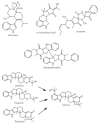Non-aflatoxigenic Aspergillus flavus to prevent aflatoxin contamination in crops: advantages and limitations
- PMID: 24575088
- PMCID: PMC3918586
- DOI: 10.3389/fmicb.2014.00050
Non-aflatoxigenic Aspergillus flavus to prevent aflatoxin contamination in crops: advantages and limitations
Abstract
Aspergillus flavus is a diverse assemblage of strains that include aflatoxin-producing and non-toxigenic strains with cosmopolitan distribution. The most promising strategy currently being used to reduce preharvest contamination of crops with aflatoxin is to introduce non-aflatoxin (biocontrol) A. flavus into the crop environment. Whether or not introduction of biocontrol strains into agricultural fields is enough to reduce aflatoxin contamination to levels required for acceptance of the contaminated food as fit for consumption is still unknown. There is no question that biocontrol strains are able to reduce the size of the populations of aflatoxin-producing strains but the available data suggests that at most only a four- to five-fold reduction in aflatoxin contamination is achieved. There are many challenges facing this strategy that are both short term and long term. First, the population biology of A. flavus is not well understood due in part to A. flavus's diversity, its ability to form heterokaryotic reproductive forms, and its unknown ability to survive for prolonged periods after application. Second, biocontrol strains must be selected that are suitable for the environment, the type of crop, and the soil into which they will be introduced. Third, there is a need to guard against inadvertent introduction of A. flavus strains that could impose an additional burden on food safety and food quality, and fourth, with global warming and resultant changes in the soil nutrients and concomitant microbiome populations, the biocontrol strategy must be sufficiently flexible to adapt to such changes. Understanding genetic variation within strains of A. flavus is important for developing a robust biocontrol strategy and it is unlikely that a "one size fits all" strategy will work for preharvest aflatoxin reduction.
Keywords: Aspergillus flavus; aflatoxin; biocontrol; cottonseed; food safety; maize; population diversity; recombination.
Figures
Similar articles
-
Biocontrol Strains Differentially Shift the Genetic Structure of Indigenous Soil Populations of Aspergillus flavus.Front Microbiol. 2019 Jul 31;10:1738. doi: 10.3389/fmicb.2019.01738. eCollection 2019. Front Microbiol. 2019. PMID: 31417528 Free PMC article.
-
Biological Control of Aflatoxin Contamination in U.S. Crops and the Use of Bioplastic Formulations of Aspergillus flavus Biocontrol Strains To Optimize Application Strategies.J Agric Food Chem. 2017 Aug 23;65(33):7081-7087. doi: 10.1021/acs.jafc.7b01452. Epub 2017 Apr 28. J Agric Food Chem. 2017. PMID: 28420231 Review.
-
Characterization and competitive ability of non-aflatoxigenic Aspergillus flavus isolated from the maize agro-ecosystem in Argentina as potential aflatoxin biocontrol agents.Int J Food Microbiol. 2018 Jul 20;277:58-63. doi: 10.1016/j.ijfoodmicro.2018.04.020. Epub 2018 Apr 13. Int J Food Microbiol. 2018. PMID: 29684766
-
Biocontrol efficacy of atoxigenic Aspergillus flavus strains against aflatoxin contamination in peanut field in Guangdong province, South China.Mycology. 2021 Oct 6;13(2):143-152. doi: 10.1080/21501203.2021.1978573. eCollection 2022. Mycology. 2021. PMID: 35711325 Free PMC article.
-
Understanding the genetics of regulation of aflatoxin production and Aspergillus flavus development.Mycopathologia. 2006 Sep;162(3):155-66. doi: 10.1007/s11046-006-0050-9. Mycopathologia. 2006. PMID: 16944283 Review.
Cited by
-
Distribution of Aspergillus Fungi and Recent Aflatoxin Reports, Health Risks, and Advances in Developments of Biological Mitigation Strategies in China.Toxins (Basel). 2021 Sep 24;13(10):678. doi: 10.3390/toxins13100678. Toxins (Basel). 2021. PMID: 34678973 Free PMC article. Review.
-
The Aspergilli and Their Mycotoxins: Metabolic Interactions With Plants and the Soil Biota.Front Microbiol. 2020 Feb 12;10:2921. doi: 10.3389/fmicb.2019.02921. eCollection 2019. Front Microbiol. 2020. PMID: 32117074 Free PMC article. Review.
-
Global health issues of aflatoxins in food and agriculture: challenges and opportunities.Front Microbiol. 2014 Aug 12;5:420. doi: 10.3389/fmicb.2014.00420. eCollection 2014. Front Microbiol. 2014. PMID: 25161651 Free PMC article. No abstract available.
-
Innovative technologies to manage aflatoxins in foods and feeds and the profitability of application - A review.Food Control. 2017 Jun;76:127-138. doi: 10.1016/j.foodcont.2017.01.008. Food Control. 2017. PMID: 28701823 Free PMC article. Review.
-
Prediction of aflatoxin contamination outbreaks in Texas corn using mechanistic and machine learning models.Front Microbiol. 2025 Mar 5;16:1528997. doi: 10.3389/fmicb.2025.1528997. eCollection 2025. Front Microbiol. 2025. PMID: 40109977 Free PMC article.
References
-
- Abbas H. K., Weaver M. A., Horn B. W., Carbone I., Monacell J. T., Shier W. T. (2011). Selection of Aspergillus flavus isolates for biological control of aflatoxins in corn. Toxin Rev. 30 59–70 10.3109/15569543.2011.591539 - DOI
-
- Abbas H. K., Zablotowicz R. M., Horn B. W., Phillips N. A., Johnson B. J., Jin X., et al. (2012). Comparison of major biocontrol strains of non-aflatoxigenic Aspergillus flavus for the reduction of aflatoxins and cyclopiazonic acid in maize. Food Addit. Contam. Part A Chem. Anal. Control Expo. Risk Assess. 28 198–208 10.1080/19440049.2010.544680 - DOI - PubMed
-
- Bayman P., Cotty P. J. (1991). Vegetative compatibility and genetic diversity in the Aspergillus flavus population of a single field. Can. J. Bot. 69 1707–1711 10.1139/b91-216 - DOI
Publication types
LinkOut - more resources
Full Text Sources
Other Literature Sources



